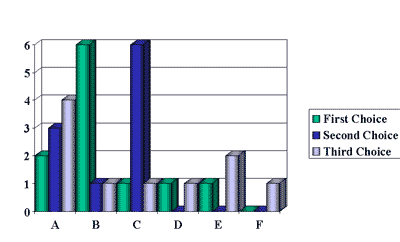| 2003 |

|
YEAR BOOK |
Letterkenny Institute of Technology
|
Teaching activities in a programmed world
|

A Analogies; B Learning by example; C Active learning; D Brainstorming; E Collaborative learning; F Case studies
The skill of learning how to program requires knowledge in various areas - including problem solving, language syntax and compilation techniques, debugging and testing a program. When learning a programming language, it is important to focus on the idea rather than the language syntax itself. Therefore, design is a very important concept: before coding a system, students should firstly develop an algorithm and then transfer that algorithm into code.
A number of teaching methods (i.e. analogies, learning by example, active learning, collaborative learning and brainstorming) may be used when teaching programming. In conjunction with the research, a survey is being carried out to determine exactly what teaching methods are most frequently utilised. The particular teaching methods used can shape how a student learns a programming language and how this language is utilised by the student.
Preliminary results suggest that learning by example is the most popular method used by 60% of lecturers. Active learning is the second most important method utilised, with analogies in third place.
Contact: Eilish Scott & Dr Averil Meehan, Computing Department, Letterkenny Institute of Technology (LYIT);
Eilish Scott Mobile: 00353 86 1039235; Fax: 00353 74 9164107;
E-Mail: [email protected]